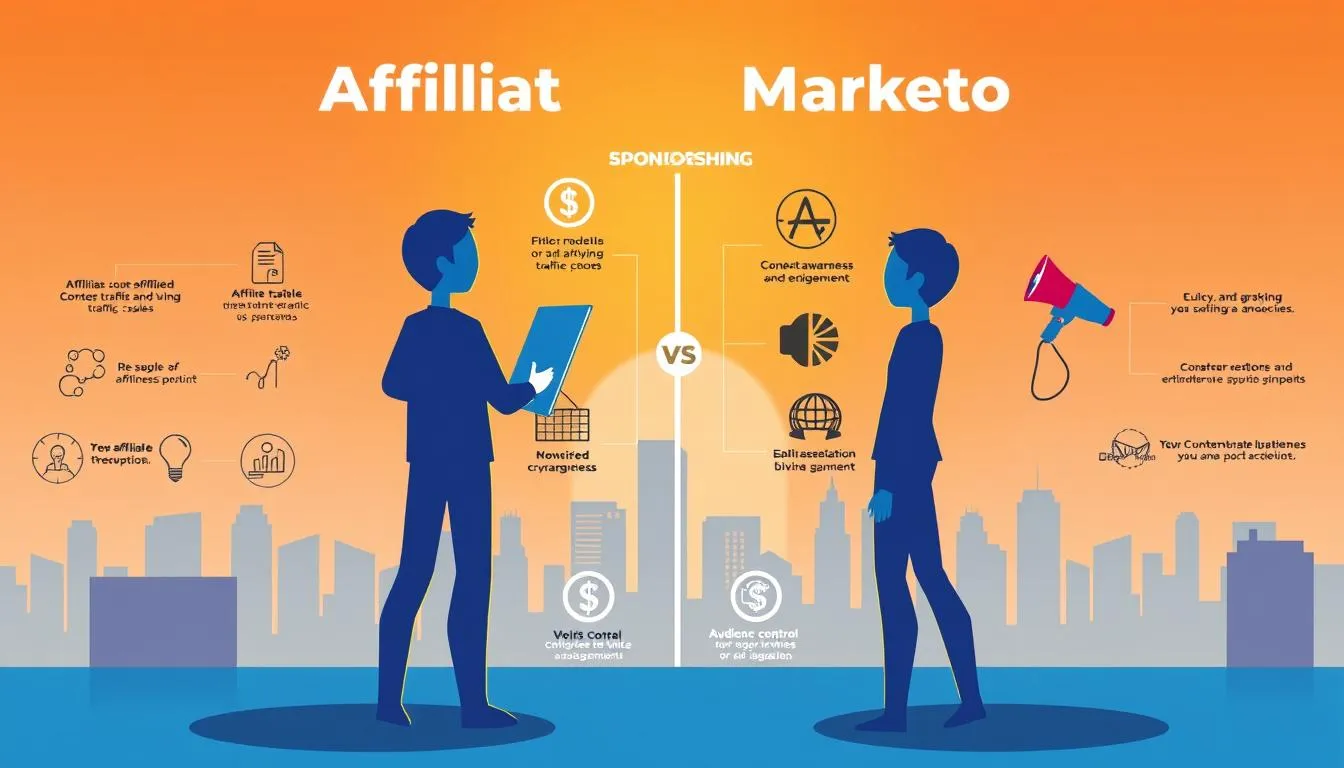Surprising fact: nearly 60% of digital marketers report faster visibility from paid integrations than from performance links in the first month.
In today’s marketing space, creators and brands choose between two clear models. One model pays creators up front to weave a message into content on a blog, video, or social feed. The other pays when a link or code drives a sale or action.
These options shape budget and outcome. Upfront deals buy immediate reach and credibility for a company or brand. Performance-based programs reward conversions and can scale as traffic grows.
Across media—from podcasts to social—your audience and goals decide the best route. This guide will map the core differences, highlight benefits and challenges, and share simple strategies to match each option to business goals and advertising ROI.
Key Takeaways
- Sponsorships deliver quick visibility and guaranteed payment.
- Performance links reward measurable conversions and long-term scale.
- Choose by budget, target audience, and desired outcome.
- Use clear disclosures to keep trust high across channels.
- Track with unique links, codes, or pixels to measure value.
Understanding the landscape: affiliate marketing and sponsored content in today’s digital media
The current digital media landscape blends paid placements and performance-driven models across many channels. This mix appears on websites, YouTube, podcasts, and social feeds. Together they shape how marketing teams plan campaigns.

Sponsored content is a paid collaboration where a brand compensates a creator to integrate a message into their social media, videos, blogs, or podcasts and tap into that creator’s audience. Companies and brands use these deals to gain quick visibility and reach new segments.
By contrast, performance models use unique tracking links or codes to credit sales and pay commissions. An influencer or creator earns only when actions occur, which makes tracking and attribution central to a marketing strategy. To maximize your affiliate earnings, explore building wealth with evergreen affiliate pillars that generate consistent passive income.
Choose channels by goal: social media for short-term buzz, a website or blog for long-form education and SEO, and podcasts or video for depth and trust. Creators and companies plan deliverables, posting cadence, and clear disclosures so audiences stay confident.
Across industries — from consumer goods to SaaS — both approaches remain core pillars of modern advertising and business growth. For more on how these methods compare, see the guide on influencer marketing and affiliate marketing differences.
Affiliate vs sponsored posts: clear definitions, how they work, and what you get paid for
How creators earn — by conversion or by contract — shapes content, tracking, and ROI.
What is affiliate marketing? Performance-based partnerships and unique tracking links
Affiliate marketing is a performance model where a company gives unique links or discount codes and the affiliate earns a commission only when a tracked sale, click, or lead occurs.
Common commission types include pay-per-sale (PPS), pay-per-click (PPC), and pay-per-lead (PPL). Cookies, partner dashboards, and payout rules in affiliate programs handle tracking and reporting.

What is a sponsored post? Upfront brand partnerships and paid promotions
Sponsorships pay creators up front for specific deliverables. Brands set timelines, creative requirements, usage rights, and require clear disclosures like #SponCon or “Paid partnership.”
These partnerships scope formats, number of posts, and licensing. They reward reach, impressions, and engagement more than direct conversions.
How affiliates and sponsors measure success: sales, actions, visibility, and engagement
Affiliates track conversions, average order value (AOV), and earnings per click (EPC). Sponsors measure reach, engagement rate, and brand lift.
Both approaches can promote services and products. The best choice depends on audience fit and whether you want direct sales or broader visibility.
| Model | Payment type | Primary metrics | Best for |
|---|---|---|---|
| Performance partnerships | Commission (PPS/PPC/PPL) | Conversions, EPC, AOV | Direct-response content and product links |
| Upfront collaborations | Fixed fee | Reach, impressions, engagement | Brand awareness and storytelling |
| Hybrid | Fee + commission | Both conversions and visibility | Long-term partnerships and campaigns |
Key differences that matter for your business, brand, and audience
Different payment models create distinct trade-offs between immediate cash and passive future earnings. Understanding those trade-offs helps you pick the right strategy for growth.

Income model and scalability
Commission-based earnings pay when a sale or action occurs. This model rewards evergreen content and search-driven traffic.
Upfront payments give quick revenue and clear scope but depend on a steady deal pipeline from a company or brand.
Earnings timeline and creative control
Commissions often compound over months as content ranks. Payout cycles may take 30–90 days.
Paid campaigns deliver lump-sum cash and set creative rules. Creators trading control for predictable revenue should document briefs and usage rights in writing.
Risk, resources, and measurement
Programs can change commission rates or attribution windows, which raises risk for long-term plans.
Sponsors focus on impressions and engagement, while performance efforts optimize to sales and EPC. Clear reporting keeps company stakeholders aligned.
- Higher-priced products usually need deeper content to convert.
- Document deliverables and expectations to reduce friction and protect revenue.
Choosing the right strategy for your goals, products, and marketing budget
Choosing the right promotional path begins with clear goals and a realistic budget. Match objectives to payment models so every dollar serves a purpose.
Budget and ROI: performance-based payouts vs fixed fees
Sponsorships require upfront spend but guarantee reach and agreed deliverables.
Performance models pay only when a sale or action happens, which protects ROI for tight budgets.
Brand visibility vs conversions
Use sponsorships to boost brand awareness quickly across new audiences.
Choose affiliate marketing when you need measurable sales or high-intent traffic for specific products and services. Learn how to create compelling content that converts with our guide to creating effective how-to affiliate posts.
Target audience and niche fit
Test broad audiences with sponsorships. Then lean on affiliates who specialize in narrow niches where buyer intent is strong.
When to favor programs for your company
- Start with budget realities: pick sponsorship for predictable deliverables; pick performance for pay-for-results.
- Channel choice: a blog with SEO favors long-term affiliate links; short social launches favor sponsorship.
- Hybrid option: run awareness campaigns, then retarget with programs that drive conversions.
How to combine affiliate marketing and sponsorships for maximum revenue
Smart creators layer payment models so a single campaign can drive both immediate reach and lasting sales.
Use affiliate links in paid content to let a sponsored message drive short-term visibility and ongoing conversions. Send readers straight to the merchant’s product page to avoid losing sales to brand social pages.
Compliance first
Always disclose relationships clearly. State that links may generate commissions and use obvious language so readers trust your content.
Choose offers that fit
Pick products that match your audience and price expectations. Creators who mirror follower needs convert better than those pushing unrelated items.
Optimize links and CTAs
Deep-link to product pages, add coupon code instructions, and use clear CTAs like “click here to buy.” These small changes cut friction and lift conversions.
Diversify channels and build evergreen assets
Publish on your website and blog, repurpose for social media and YouTube, and follow up with segmented email to capture late buyers.
Create a persistent “Shop” or Favorites page populated with programs and live promo snippets. This builds passive revenue long after a sponsorship window ends.
“Send readers directly to the merchant product page, make links obvious, and disclose commissions.” — Practical tip from affiliate managers
| Action | Why it works | Quick tip |
|---|---|---|
| Layer links in paid content | Immediate exposure + ongoing sales | Include one deep-link per feature |
| Clear disclosure | Maintains audience trust | Use simple language and visible placement |
| Evergreen shop page | Drives steady revenue | Auto-update promo snippets when available |
Real-world scenarios: which strategy fits your marketing goals right now
When a product hits the market, the right promotional mix can decide whether it sparks immediate interest or builds steady demand. Use clear objectives to guide the trade-off between fast exposure and long-term revenue.
Launching a new product or brand campaign: prioritize sponsored content
Choose sponsored content when a company needs speed, broad reach, and controlled messaging. Paid placements across blogs, video, and social posts get a new product in front of large audiences fast.
Try influencer unboxings or tutorial features to jumpstart discovery. For smaller companies, test micro-influencers to validate creative and messaging before scaling.
Tip: pair a giveaway or awareness push with clear CTAs so interested users move toward your site or email list.
Driving consistent sales from niche audiences: lean into affiliate strategies
For steady conversions, use performance programs that reward ongoing traffic and search intent. Evergreen content on a company blog or niche channels compounds sales over time. To maximize your affiliate blog’s visibility and rankings, implement proven SEO strategies for affiliate blogs.
Retarget users who discovered your product via a sponsored piece and send them to conversion-focused pages with tracking links and coupon codes.
Measure both exposure and downstream revenue so your marketing budget can shift dynamically to the higher-performing channel.
- Awareness KPIs: favor sponsorship for reach and sentiment.
- Revenue KPIs: favor commission-based programs for conversions and ROAS.
- Combine tactics: sponsor discovery, then scale the best placements with performance-driven links.
For practical influencer guidance, review this short guide on influencer marketing to align partnerships with your goals.
Conclusion
Use sponsorship to ignite reach and performance programs to drive measurable sales. Combine both to unlock short-term visibility and long-term revenue.
Start with clear goals: choose the model that matches your product, audience, and budget. Document partnerships, disclose relationships, and place direct links to product pages for low-friction conversions.
Layer affiliate programs inside paid features, keep an evergreen shop on your website or blog, and nurture leads with segmented email to extend value. Track attribution windows and revenue trends so you can reallocate spend to top-performing paths.
For compliance tips, review this affiliate disclosure guidance. Use the checklist—goal clarity, offer fit, compliant disclosures, optimized links, and measurement—to turn strategy into steady growth.
FAQ
What’s the main difference between affiliate marketing and sponsored posts?
Affiliate programs pay creators a commission when a tracked link or code leads to a sale or action. Sponsored content involves an upfront fee from a brand to publish a promotion, often with specific messaging or placement requirements.
How do performance-based partnerships work with tracking links?
Creators use unique tracking links or coupon codes tied to their accounts. When a visitor clicks the link or uses the code and completes a purchase or sign-up, the platform or merchant attributes credit and issues a commission to the publisher.
What should I expect to get paid for a sponsored promotion?
Sponsored work typically pays a flat fee, which can vary by audience size, engagement, platform, and deliverables. Rates reflect reach, production effort, and exclusivity rather than direct sales performance.
How do brands and creators measure success for these two approaches?
For commission programs, success metrics focus on conversions, average order value, and ROI. For paid partnerships, brands track impressions, engagement, website traffic, and alignment with campaign goals like awareness or clicks.
Which income model is better for long-term revenue stability?
Commission-based links can create ongoing, passive income as content continues to drive sales. Upfront deals provide predictable short-term revenue but require repeat bookings for sustained income.
Can sponsored campaigns scale the same way affiliate revenue can?
Sponsored campaigns scale with your negotiation power and brand demand but are often deal-dependent. Affiliate earnings scale with evergreen content and audience reach, producing compounding returns over time.
How does creative control differ between the two formats?
Sponsored work often comes with brand guidelines and required messaging, which can limit creative freedom. Promotional links or affiliate mentions usually allow more editorial control so long as disclosure and product accuracy are maintained.
What risks and resources should creators consider for each option?
Relying on sponsorships can leave income uneven between deals and demands more outreach and negotiation. Commission-based models depend on merchant stability, cookie window length, and accurate tracking, so diversify to reduce risk.
How should a company choose between paying commissions or buying sponsored content?
If your goal is direct sales and measurable ROI, performance-based payouts make sense. If you need brand awareness or control over messaging for a launch, a paid partnership can deliver predictable visibility.
When does affiliate-style promotion outperform sponsorships for conversion?
Promotions tied to intent—product reviews, tutorials, or “best of” roundups—tend to convert better via tracked links and codes because the audience already has purchase intent. For specific techniques to enhance your review content performance, check out our comprehensive review post optimization tips.
How can creators combine both approaches to maximize revenue?
Use paid partnerships for launches or awareness and include affiliate links for ongoing conversions. Disclose relationships clearly, link directly to product pages or coupon landing pages, and promote across website, social channels, YouTube, and email.
What compliance steps should publishers and brands always follow?
Always use clear FTC disclosures, label promotional content, and ensure link transparency. Honesty builds trust with an audience and keeps partnerships compliant across platforms.
Which channels work best for affiliate links and promotional content?
High-conversion channels include niche blogs, product review pages, YouTube tutorials, and targeted email newsletters. Social media and short-form video can drive awareness and traffic but often need strong calls to action.
How do I optimize links and promotions to improve conversions?
Send traffic to focused product pages, use time-limited coupon codes, craft clear calls to action, and test landing pages. Track performance and iterate on headlines, visuals, and placement to boost sales.
What kinds of content make good evergreen assets for ongoing revenue?
“Best of” guides, curated shop pages, seasonal gift lists, and resource pages that automatically update promotions deliver steady traffic and compound earnings over time.
